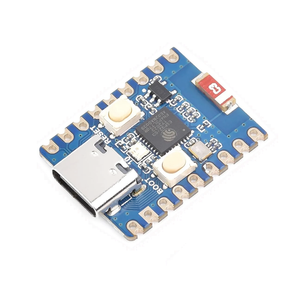
ESP32-S3-Zero is a development board based on the ESP32S3 microcontroller using XTENSA architecture.
This board features a maximum CPU frequency of 240 MHz and 4MB flash memory.
About ESP32-S3-Zero
The ESP32-S3-Zero is a compact development board featuring the Espressif ESP32-S3FH4R2 dual-core processor, operating at up to 240MHz. It offers 2.4GHz Wi-Fi (802.11 b/g/n) and Bluetooth 5 (LE) capabilities, making it ideal for IoT projects requiring robust wireless connectivity. 📶
With its small form factor of 23.5 × 18 mm, the board is designed for easy integration into space-constrained applications. The onboard ceramic antenna ensures stable wireless performance without the need for an external antenna.
For user convenience, the ESP32-S3-Zero includes both a BOOT button and a RESET button, facilitating straightforward development and debugging processes. 🚀
Equipped with 24 multifunctional GPIO pins, the board supports various interfaces, including:
- 4 × SPI
- 2 × I2C
- 3 × UART
- 2 × I2S
- 2 × ADC
Where to Buy ESP32-S3-Zero
Prices are subject to change. We earn from qualifying purchases as an Amazon Associate.
📋 Technical Specifications
Complete technical specification details for ESP32-S3-Zero
🛰️ Connectivity
🧠 Microcontroller
✨ Features & Pins
- • Ultra-compact size: 23.5 × 18 mm
- • Low power consumption: supports various power modes for energy-efficient applications
- • Onboard WS2812 RGB LED connected to GPIO21
ESP32-S3-Zero Board Dimensions
Physical measurements for ESP32-S3-Zero
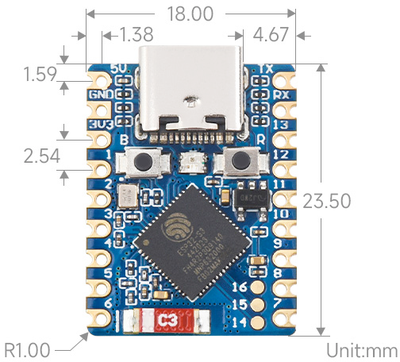
ESP32-S3-Zero Pinout Diagram
Complete pin reference for ESP32-S3-Zero
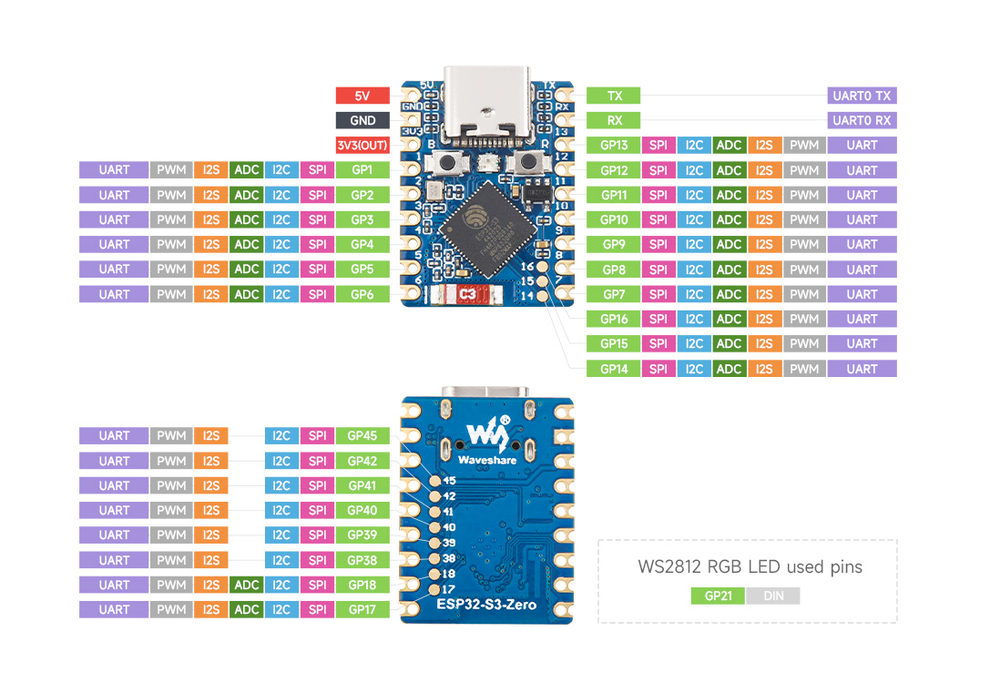
The ESP32-S3-Zero pinout is engineered for versatility within a compact footprint. Key power pins include 5V, 3.3V, and GND, ensuring reliable power delivery for various peripherals.
The board offers multiple communication interfaces:
- UART: TX (GPIO43), RX (GPIO44)
- I2C: SDA, SCL
- SPI: SCK, MISO, MOSI, SS
For analog input, it provides ADC pins suitable for reading sensor data or voltage levels.
✅ Safe Pins to Use
These pins are safe for general GPIO usage without boot or system conflicts
💡 Why Are These Pins Safe?
⚠️ Pins to Avoid or Use with Caution
Reserved for critical functions. Misuse may cause boot failures, programming issues, or system conflicts.
Boot behavior & flash voltage
Low-level debugging interface
USB Serial/JTAG communication
Memory & PSRAM connections
Debugging & firmware uploads
| PIN | Label | Why Avoid | Type |
|---|---|---|---|
| IO3 | GPIO3 | Sampled at reset to select JTAG interface (USB Serial/JTAG controller vs. external pins). Improper use can disable external JTAG or alter debug interface. | 🛠️ Strapping |
| IO9 | FSPIHD | Connected to external flash (data/hold signal) on most modules. Not recommended for use as GPIO, since it must remain dedicated to flash communication. | ⚡ Flash |
| IO10 | FSPICS0 | Used to select the external flash chip. It is required for flash access and cannot be repurposed without losing flash connectivity | ⚡ Flash |
| IO11 | FSPID | Used as a data line for flash (and in-package PSRAM). It should not be used as GPIO when the flash/PSRAM is in use. | ⚡ Flash |
| IO12 | FSPICLK | Drives the flash (and PSRAM) clock. This critical signal must be reserved for memory and not used as general GPIO. | ⚡ Flash |
| IO13 | FSPIQ | Used as a data line for flash/PSRAM transfers. Not available for other uses when flash/PSRAM is connected. | ⚡ Flash |
| IO14 | FSPIWP | Connected to external flash (data/write-protect signal). Not recommended as GPIO because it’s reserved for flash operations. | ⚡ Flash |
| IO38 | FSPIWP | On flash-equipped chips, this pin is tied to the flash’s WP# (or D3) line. It should be avoided for other use, as it’s needed for flash operations. | ⚡ Flash |
| IO39 | MTCK (GPIO39) | Default JTAG debugging TCK pin. If JTAG is needed, this pin must be free; it may also be used internally for PSRAM chip select on certain modules, so avoid repurposing it. | 🪛 Other |
| IO40 | MTDO (GPIO40) | Default JTAG TDO output for debugging. Using it as GPIO will interfere with JTAG debugging functionality. | 🪛 Other |
| IO41 | MTDI (GPIO41) | Default JTAG TDI input for debugging. Should be reserved for JTAG or left unused if JTAG is to remain available. | 🪛 Other |
| IO42 | MTMS (GPIO42) | Default JTAG TMS signal for debugging. Using this pin for other purposes will disable the JTAG interface (unless JTAG is rerouted to USB). | 🪛 Other |
| IO45 | GPIO45 | Determines flash/PSRAM power voltage (3.3 V vs 1.8 V) at boot. Must match hardware configuration; using as GPIO can upset flash supply setting. | 🛠️ Strapping |
Useful Links
Datasheets and resources for ESP32-S3-Zero
ESP32-S3-Zero Custom Pin Mapping
Pin configuration and GPIO mapping for ESP32-S3-Zero
| Pin | Function | ESP Pin | I/O Type | Description |
|---|---|---|---|---|
| 1 | 5V | 5V | POWER INPUT | 5V power input for the board |
| 2 | GND | GND | POWER GROUND | Ground connection |
| 3 | 3V3 | 3.3V | POWER OUTPUT | 3.3V power output |
| 5 | IO1 | IO1 | BIDIRECTIONAL | GPIO, ADC |
| 6 | IO2 | IO2 | BIDIRECTIONAL | GPIO, ADC |
| 7 | IO3 | IO3 | BIDIRECTIONAL | GPIO, ADC |
| 8 | IO4 | IO4 | BIDIRECTIONAL | GPIO, ADC |
| 9 | IO5 | IO5 | BIDIRECTIONAL | GPIO, ADC |
| 10 | IO6 | IO6 | BIDIRECTIONAL | GPIO, ADC |
| 11 | IO7 | IO7 | BIDIRECTIONAL | GPIO, ADC |
| 12 | IO8 | IO8 | BIDIRECTIONAL | GPIO, ADC |
| 13 | IO9 | IO9 | BIDIRECTIONAL | GPIO, ADC |
| 14 | IO10 | IO10 | BIDIRECTIONAL | GPIO, ADC |
| 15 | IO11 | IO10 | BIDIRECTIONAL | GPIO, ADC |
| 16 | IO12 | IO10 | BIDIRECTIONAL | GPIO, ADC |
| 17 | IO13 | IO10 | BIDIRECTIONAL | GPIO, ADC |
| 18 | IO14 | IO10 | BIDIRECTIONAL | GPIO, ADC |
| 19 | IO15 | IO10 | BIDIRECTIONAL | GPIO, ADC |
| 20 | IO16 | IO10 | BIDIRECTIONAL | GPIO, ADC |
| 21 | IO17 | IO10 | BIDIRECTIONAL | GPIO, ADC |
| 22 | IO18 | IO10 | BIDIRECTIONAL | GPIO, ADC |
| 23 | IO38 | IO10 | BIDIRECTIONAL | GPIO |
| 24 | IO39 | IO10 | BIDIRECTIONAL | GPIO |
| 25 | IO40 | IO10 | BIDIRECTIONAL | GPIO |
| 26 | IO41 | IO10 | BIDIRECTIONAL | GPIO |
| 27 | IO42 | IO10 | BIDIRECTIONAL | GPIO |
| 28 | IO45 | IO10 | BIDIRECTIONAL | GPIO |
Default Tools & Configuration
Build and upload settings for ESP32-S3-Zero
| Setting | Value |
|---|---|
| Bootloader tool | esptool_py |
| Uploader tool | esptool_py |
| Network uploader tool | esp_ota |
| Bootloader address | 0x0 |
| Flash mode | qio |
| Boot mode | qio |
| Maximum upload size | 4096 KB (4194304 bytes) |
| Maximum data size | 512 KB (524288 bytes) |
The ESP32-S3-Zero uses esptool_py for uploads , esp_ota for OTA updates, and esptool_py bootloader at 0x0.
Flash mode: qio | Boot mode: qio
Max sketch size: 4096 KB | Max data size: 512 KB
Similar Boards
Other development boards with ESP32S3 microcontroller
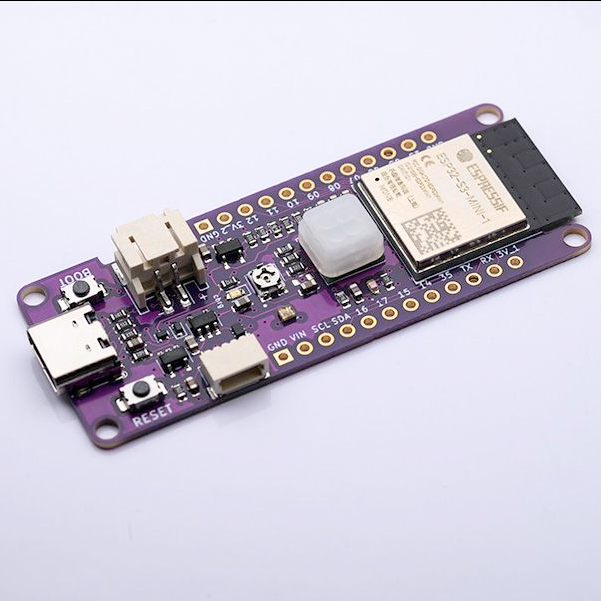
Bee Motion S3
Bee Motion S3 development board is based on esp32s3 microcontroller and uses xtensa architecture.
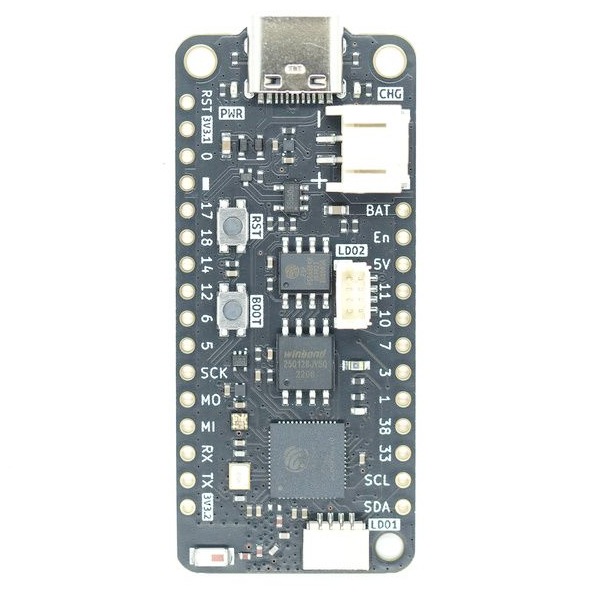
UM FeatherS3
UM FeatherS3 development board is based on esp32s3 microcontroller and uses xtensa architecture.
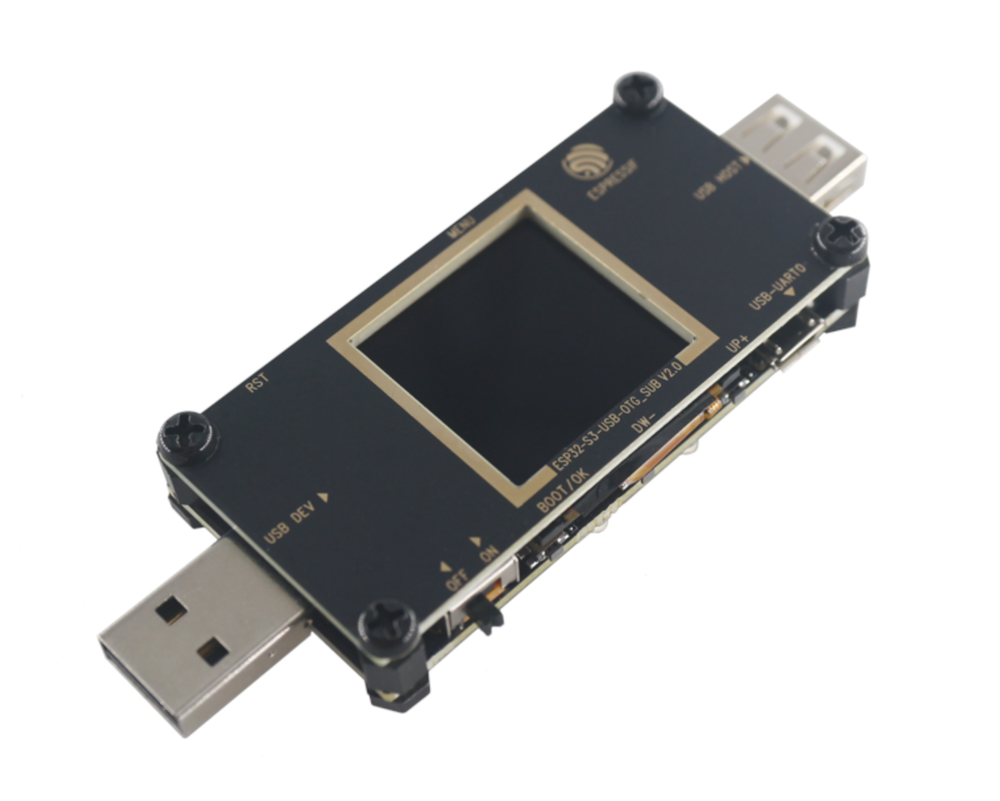
ESP32-S3-USB-OTG
ESP32-S3-USB-OTG development board is based on esp32s3 microcontroller and uses xtensa architecture.



